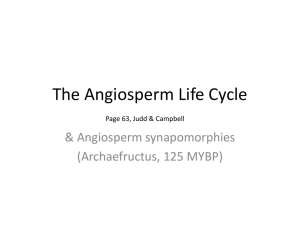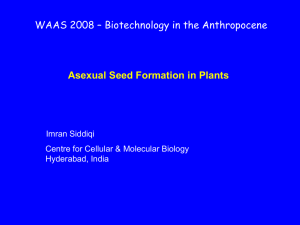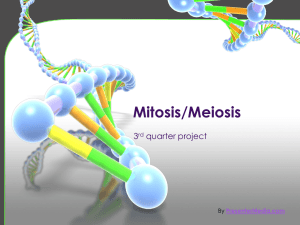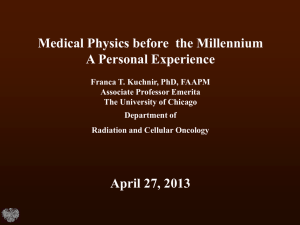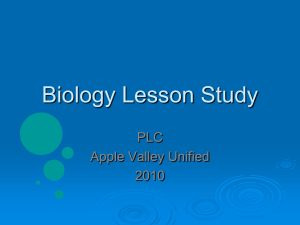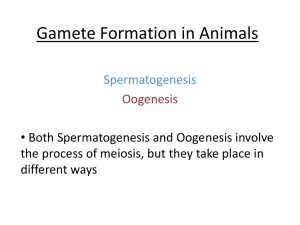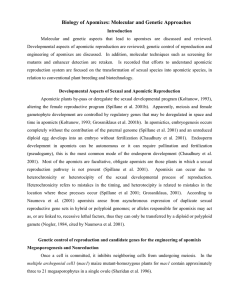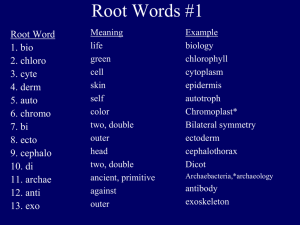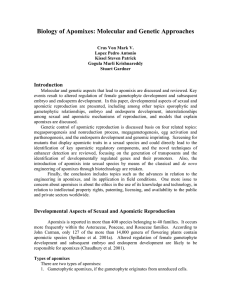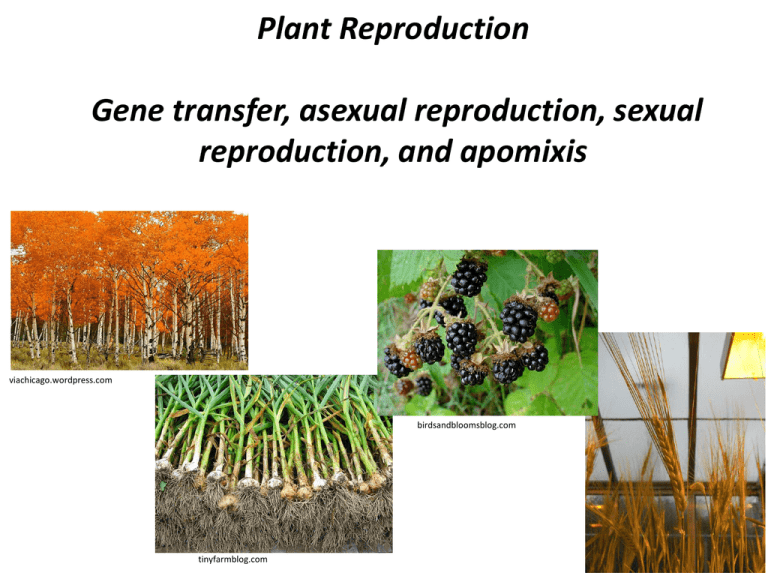
Plant Reproduction
Gene transfer, asexual reproduction, sexual
reproduction, and apomixis
viachicago.wordpress.com
birdsandbloomsblog.com
tinyfarmblog.com
Asexual reproduction
The clone is immortal
Example: Allium sativum
“As far as we know, garlic in cultivation throughout history has
only been propagated asexually by way of vegetative cloves,
bulbs, and bulbils (or topsets), not from seed. These asexually
propagated, genetically distinct selections of garlic we cultivate
are more generally called "clones". Yet this asexual lifestyle of
cultivated garlic forgoes the possibility of combining traits
proffered by interpollinating diverse parental stocks.”
Source: http://www.ars.usda.gov/Research/docs.htm?docid=5232
Asexual reproduction
The clone is immortal
Example: Populus tremuloides
• The world's heaviest living thing
• 1 clone in the Wasatch Mountains of Utah
• 47,000 stems of genetically identical aspen trees
• Total weight: 6 million kilograms
• Aspen is dioecious species - this clone is one big male
source: http://waynesword.palomar.edu/ww0601.htm#aspen
Sexual reproduction
Advantages > disadvantages
• Advantages:
• Genetic variation:
• Allele exchange via cross-pollination
• New combinations of alleles via meiosis
• Purge deleterious mutations
• Stay ahead in the host-pathogen “arms race”
• Potential adaptation to a changing climate
Sexual reproduction
Advantages > disadvantages
• Disadvantages:
• In a dioecious species, half the reproductive effort is wasted in
producing males
• Meiosis produces some "unfit" combinations of alleles
• Cross-pollinated plants may be subject to environmental conditions
unfavorable to pollination
• Finding a mate!
Alternation of generations
In plants there is an alternation of the gametophytic (n) and
sporophytic (2n) generations
(Gametophytic = haploid)
Alternation of generations
The sporophytic generation may be diploid (2n = 2x) or polyploid (2n = _x)
1 pair homologous chromosomes
0 sets of homoeologous chromosomes
AA
A A
VAVA
2n = 2x = 14
30,000 genes
2 pairs of homologous chromosomes
2 sets of homoeologous chromosomes
AABB
A ABB
VAVAVBVB
2n = 4x = 28
60,000 genes
3 pairs of homologous chromosomes
3 sets of homoeologous chromosomes
AABBDD
A ABBDD
VAVAVBVBVDVD
2n = 6x = 42
90,000 genes
Angiosperm reproductive organs and gamete
formation
Development of the female gametophyte
• Reproductive structure: Ovule(s), style, stigma
http://www.extension.org/pages/32204/stigma
Angiosperm reproductive organs and gamete
formation
Development of the female gametophyte
Megaspore mother cell (MMC)
• MMC undergoes meiosis
• Of 4 megaspores produced 1 survives (most species)
• Three post-meiotic mitoses
1
2
3
Angiosperm reproductive organs and gamete
formation
Development of the female gametophyte
The 8-nucleate embryo sac (1 egg, 2 synergids, 2 primary
endosperm nuclei, 3 antipodals)
Source: yougems.reflectionsinfos.com
lima.ohio-state.edu
Angiosperm reproductive organs and gamete
formation
Development of the female gametophyte
Pollinator attraction: Petals, nectaries, etc.
Source: arizonabeetlesbugsbirdsandmore.blogspot.com
Angiosperm reproductive organs and gamete
formation
Development of the male gametophyte
Reproductive structures: Anthers; pollen within anthers
Angiosperm reproductive organs and gamete
formation
Development of the male gametophyte
Pollen mother cell (PMC)
• PMC undergoes meiosis
Note, this is
different than ♀
Meiosis 1
Meiosis 2
• Meiosis gives a tetrad of microspores
Angiosperm reproductive organs and gamete
formation
Development of the male gametophyte
The first mitosis gives vegetative and generative
nuclei; at the second mitotic division, the generative
nucleus gives 2 sperms.
mitosis
mitosis
mitosis
mitosis
mitosis
mitosis
mitosis
mitosis
The pollen pathway and double fertilization
• The stigma is the site of pollen recognition
• Pollen germinates and the vegetative (tube nucleus)
grows through the style to the ovule
• The two sperm use the tube as conduit
The pollen pathway and double fertilization
Double fertilization: One sperm fertilizes the egg to give
the 2n embryo, the other fertilizes the polar nuclei to give
the 3n endosperm
antipodals
♀
♀
♀
♀
polar
nuclei
synergids
3n
endosperm
♂
♀
egg
♀
♂
2n
embryo
The pollen pathway and double fertilization
After double fertilization, there are at least four
independent and genetically distinct generations
coexisting in the seed:
• maternal sporophyte diploid tissue
• maternal gametophyte haploid tissue
• offspring sporophyte diploid tissue
• fusion of male (1) and female (2) gametophyte to
form triploid tissue
A review…
MMC
Vv
v
v
V
V
v
v
V
V
V
V
V
V
v
v
v
v
Vv
sporophytic
generation
PMC
Vv
VVV
VV
VVV
v v v
v v
v v v
v
V
v v
V V
v
V
v
V
v
V
v v
V V
A review of sexual reproduction in an F1 plant,
heterozygous for the Vv locus
v
v v
V
V V
V
V V
+
+
VVV
VV
VVV
v v v
v v
v v v
=
=
+
VVV
VV
VVV
=
VVv
Vv
VVV
VV
v vV
v V
V
v
V
VV
Vv
v
Vv
vv
v
v v v
v v
v v v
v v
+
=
v v v
v v
Note: At this point in the figure, the antipodals and synergids are deleted and only the
fertilized endosperm nuclei (now 3n) and fertilized egg (now 2n) are shown. Only the fertilized
egg is carried to the Punnett square.
Seeds without sex: Apomixis
Apomixis involves parthenogenesis – development of an egg
without fertilization, as opposed to parthenocarpy –
development of fruits (seedless) without fertilization
Implication - Apomixis allows for seed propagation of a
heterozygote – genetically identical from generation to
generation.
1. Obligate:
2. Facultative:
Seeds without sex: Apomixis
Source: Grossniklaus et al. 2001. The Plant Cell.
Seeds without sex: Apomixis
Economic implications of apomixis
• Why would apomixis be, or not be, of commercial
interest to purveyors of hybrid seeds?
• If transgenic apomicts are developed and released,
and if apomixis is dominant, it will be necessary to
control pollen flow – if not, there will be frozen gene
pools
Evolutionary implications of apomixis
• Obligate vs. facultative
Seeds without sex: Apomixis
Prevalence
400 species ; 40 families; Common in Poaceae,
Asteraceae, Rosaceae
• Examples
• Tripsacum
• Poa pratensis
• Pennisetum
• Dandelion (Taraxacum spp)
• Rubus
Seeds without sex: Apomixis
How it works
•
no (or altered) meiosis to produce unreduced female
gametophyte (embryo sac)
•
no fertilization – but do get autonomous embryo
formation
•
may have autonomous endosperm development, or
endosperm development may be triggered by
fertilization. Most cases it is triggered by fertilization
(pseudogamy = fertilization of central cell)
Seeds without sex: Apomixis
Genetic basis
•
Reported to be anything from one gene to many
•
Lots of breeding effort; little success
•
Perhaps all genes related to megasporogenesis!
The Rubus armeniacus case study
Himalayan (Armenian) blackberry
Is the Himalayan blackberry the perfect weed?
Designing the perfect invasive
Attribute
Description
Flower
Hermaphroditic
Pollination biology
Self and outcross
Apomixis
Facultative
Seeds
Small and numerous
Vegetative propagation
Yes
Ploidy level
Polyploid
Protection
Thorns
Attraction
Tasty fruit
Was Luther Burbank the
“father” of this perfect weed?
promo.idahopotato.com

